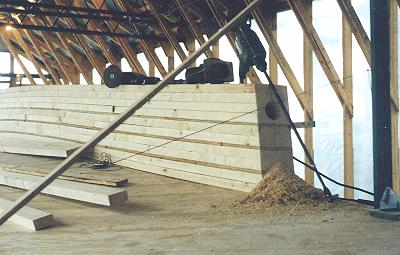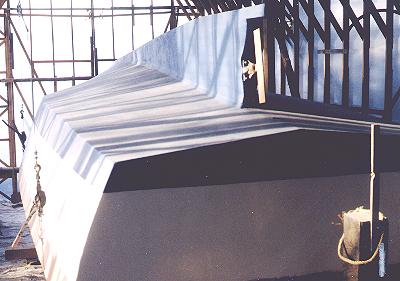Building the Glen-L Yukon
by Wayne Milner
Page 7
This boat has a large skeg. It is made of a stack of laminated 2x6 lumber. It took a lot of lumber. I made it out of kiln-dried spruce, which is less expensive than Douglas fir. Every two or three layers, I put a layer of plywood. I thought this would make the skeg less likely to split, and it used up some of the scrap plywood that was lying around. The shaft hole was cut as a slit in each piece as it was applied. When the skeg was built up enough to take in all of the shaft hole, I reamed out the hole with a made-up drill bit attached to a couple of lengths of 1/2-inch threaded rod.
 The skeg, shown here partially completed with shaft hole drilled, is laminated from a stack of 2x6 lumber and 6-inch-wide strips of plywood.
The skeg, shown here partially completed with shaft hole drilled, is laminated from a stack of 2x6 lumber and 6-inch-wide strips of plywood. |
The skeg was fitted and the shaft hole made before the fiberglass cloth was applied to the hull. After fitting, the skeg was removed as a unit, and the cloth and epoxy were applied to the hull and allowed to set up. The skeg was then epoxied into place and fastened through the hull and floors with 1/2-inch threaded rods. Holes for the rods were bored through each layer of the skeg as it was set up, and reamed when all layers were in place. The rods were then driven through the holes and nuts and washers were put on each end. The skeg was then fiberglassed. I concluded later that fitting the skeg first was probably a waste of time.
I made up a tube for the shaft by wrapping several layers of fiberglass cloth saturated with epoxy around a long cardboard tube that had first been wrapped with waxed paper. After the epoxy had set up, I soaked the whole thing in water until the cardboard softened up enough to come out easily. I fitted the end of the shaft tube to the stern bearing holder so that it fit tightly inside, then removed it. I attached the stern bearing holder to the aft side of the skeg, coated the end of the stern tube with epoxy, and hammered it into the forward end of the stern tube bearing holder from inside the boat. After the boat was turned over, the stern tube was cut off flush with the inside of the keel. Epoxy was poured around the tube to fill the space between the outside of the tube and the keel and skeg. The inside shaft log was then bolted in place.
 At this point, the hull is completed, including paint, ready to be turned over. Note the dummy prop used to insure proper clearances.
At this point, the hull is completed, including paint, ready to be turned over. Note the dummy prop used to insure proper clearances. |